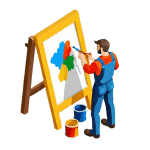Color Harmony Demystified: Crafting Mesmerizing Artwork Through Pigment Magic
Imagine your canvas as a playground of colors, where each hue dances with the other like notes in a symphony. Color harmony is the conductor, orchestrating a masterpiece that captivates the eye and stirs the soul. How do you wield the power of color to create art that resonates deeply? Let's unlock the secrets of color harmony, where pigment magic transforms your creations into mesmerizing works of art.
Colors have a language of their own – they evoke emotions, tell stories, and create atmospheres. Think of your canvas as a stage, and colors as actors stepping into their roles. From passionate reds that ignite the canvas to serene blues that whisper tranquility, each color brings its own voice to the composition.
Just as a chef blends ingredients to create a delightful dish, you, too, blend colors to create visual feasts. But it's not just about mixing colors; it's about crafting harmonious palettes that resonate with the viewer. Imagine a bouquet of flowers – each petal a different color, yet together, they form a symphony of beauty.
- The Symphony of Colors: An Introduction to Color Harmony
Color harmony isn't just about aesthetics; it's about emotions. Picture your canvas as a canvas of feelings, waiting for your brush to translate them into visual language. Warm colors like reds and yellows exude energy and passion, while cool blues and greens evoke calm and tranquility. Through color, you're weaving a tale that transcends words.
Have you ever wondered how some paintings seem to glow with an inner light? It's the magic of color harmony at play. Imagine a sunset – the fiery oranges blending seamlessly with the purples and blues. This natural phenomenon, mirrored on your canvas, has the power to transport your audience into the heart of your creation.
But wait, how do you navigate the vast ocean of colors available to you? This is where the color wheel becomes your compass. Just as a sailor relies on the stars to find their way, you'll use the color wheel to navigate the realm of color harmony. This tool demystifies the relationships between colors, guiding you to craft palettes that sing in unison.
- Emotions on Canvas: How Colors Evoke Feelings and Moods
- The Color Wheel Unveiled: Understanding the Basics of Color Theory
As you journey into the realm of color harmony, remember that you're not just mixing pigments – you're crafting emotions. Your palette is your palette of feelings, waiting to be unveiled stroke by stroke. With each color choice, you're composing a symphony of sensations that resonate deeply with your audience.
Creating Harmonious Palettes: Techniques to Mix and Match Colors
Picture your palette as a treasure trove of possibilities, where colors await your command to come alive. Crafting harmonious palettes is like arranging a bouquet – each color plays a unique role, contributing to the overall harmony. But how do you mix and match colors with finesse, creating combinations that delight the eye and evoke emotion?
Imagine your palette as a garden, each color a flower that blooms in its own time. Begin by selecting a dominant color, the star of your composition. This color sets the tone and mood, guiding the others like a conductor leading an orchestra. Think of it as the main melody, and the other colors as supporting harmonies that enrich the composition.
- Creating Harmonious Palettes: Techniques to Mix and Match Colors
But it's not just about dominance – it's about balance. Just as a tightrope walker maintains equilibrium, you'll balance warm and cool tones, light and dark values. Imagine a seesaw – if you add a heavy weight on one side, you balance it with a lighter weight on the other. This equilibrium creates visual interest and depth in your artwork.
Experimentation is your ally in this journey. Mix colors on your palette like a mad scientist concocting potions. Imagine your palette as a laboratory, each color a mysterious ingredient waiting to reveal its magic. Through trial and error, you'll discover unexpected pairings that elevate your art from mundane to extraordinary.
Now, let's talk about contrast – the secret ingredient that adds drama to your composition. Imagine a moonlit night, where the darkness of the sky makes the stars shine brighter. Contrast is like a spotlight, directing the viewer's gaze to the focal points of your artwork. The interplay between light and shadow creates a dynamic interlude that keeps the eye engaged.
As you venture into the realm of color mixing, remember that you're not just a painter – you're a master of alchemy. Your palette is your cauldron, and your colors are the ingredients of your spell. With each stroke, you're weaving enchantment, crafting palettes that dance with life and emotion.
The Role of Contrast: Adding Depth and Drama to Your Art
Imagine your canvas as a stage where light and shadow perform a dance that mesmerizes the eyes. Contrast, the conductor of this visual symphony, adds depth and drama to your artwork. How do you wield this powerful tool to guide the viewer's gaze and create compositions that are not only captivating but also emotionally resonant?
Think of contrast as the storyteller of your art. Imagine a campfire at night – the flickering flames against the darkness, each enhancing the other's beauty. Contrast is like the narrator that draws attention to your focal points, revealing the secrets that lie within the shadows. It's the element that transforms a flat image into a three-dimensional world.
- The Role of Contrast: Adding Depth and Drama to Your Art
But contrast isn't just about light and dark – it's about variation. Just as a song has crescendos and decrescendos, your artwork has areas of intensity and subtlety. Imagine a landscape where rolling hills meet the vast expanse of the sky. The meeting point is a realm of contrast, a juncture that captures the essence of your composition.
Texture is another facet of contrast that adds tactile depth to your artwork. Imagine a rough stone wall against a smooth pathway – the juxtaposition ignites curiosity and intrigue. Texture is like a secret passage that the viewer's senses explore, inviting them to touch and feel the emotions embedded in your creation.
And what about color contrast? Imagine a vibrant red against a sea of calm blues – the red pops with intensity, demanding attention. Just as a soloist stands out in an ensemble, a strategically placed burst of color creates visual impact. Color contrast is the spotlight that highlights specific elements, creating a visual hierarchy that guides the viewer's gaze.
As you embrace the role of contrast in your art, remember that you're not just painting with pigments – you're painting with emotions. Your canvas is a stage, and contrast is the script that adds suspense, intrigue, and depth. With each stroke, you're not only creating an image, but a world that invites exploration and connection.

